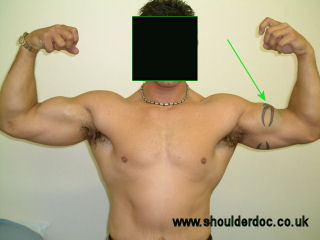Bicep Tendon Rupture
The biceps muscle is the large muscle in the front of your upper arm. It is the muscle most flexed by strongmen in demonstrating their muscles. The biceps is attached at the top in the shoulder and then below the elbow into the radius bone by a strong tendon.
This strong tendon at the elbow can rupture with a very strong contraction of the biceps muscle. People may feel a pop in the elbow and pain. This usually happens when the tendon is already worn and prone to injury.
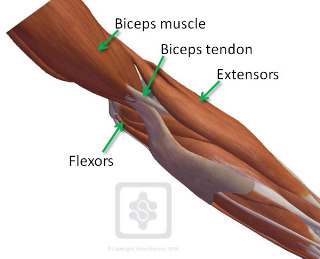
The people most likely to get a biceps tendon rupture are strength athletes, bodybuilders and heavy manual workers. Generally, males over the age of 35 years. Unlike other tendon ruptures, steroid use has not been shown to be involved in the rupture of the distal biceps.
After the injury there is usually localised pain at the front of the elbow, with bruising and swelling. The biceps muscle may retract up the upper arm crating a prominent bump, known as the ‘Popeye’ sign. This is often visibly different to the other biceps when contracting the muscle.
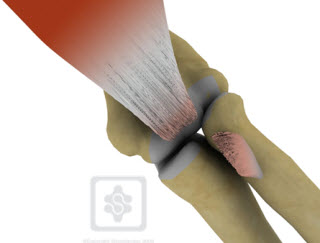
Distal biceps tendon rupture
A biceps tendon rupture leads to weakness of the elbow and forearm if not repaired. People have difficulty twisting a screwdriver, turning a key and lifting weights. This is due to 55% reduction in forearm twisting strength (supination power) and 36% reduction in elbow bending strength (flexion power).
Therefore, early operative repair is the treatment of choice to restore full strength and correct the deformity. Repair should be undertaken within 3 weeks of the injury, or as early as possible.
There are many different repair techniques. We favour a small (percutaneous) approach, reattaching the tendon down to the bone. The repair is strong and patients can start moving soon after the surgery. However lifting must be avoided for at least 6 weeks after surgery. Click here for more details .
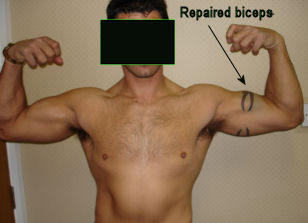
A biceps tendon rupture that is over 4 weeks old is often more difficult to repair directly. The tendon is often retracted up the arm and stuck, so a second higher incision may be made to retrieve it. Sometimes a reconstruction with another tendon might be required. In such chronic cases we ‘bridge’ the repair and reinforce it with either tendon from the patient’s thigh (tensor fascia lata) or a tendo-achilles allograft . This is similar to the ligaments used in knee ligament reconstructions
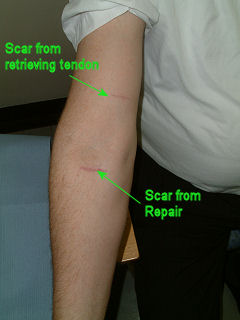
References:
- Baker BE, Bierwagen D. Rupture of the distal tendon of the biceps brachii: Operative versus non-operative treatment. J Bone Joint Surg. 1985;67A:414-417.
- Morrey BP, Askew LJ, An KN, Dobyns JH. Rupture of the distal tendon of the biceps brachii: A biomechanical study. J Bone Joint Surg. 1985;67A:418-421.
- Hang DW, Bach BR, Bojchuk J. Repair of chronic distal biceps brachii tendon rupture using free autogenous semitendinosus tendon. Clin Orthop. 1996;323:188-191. Abstract
- Levy HJ, Mashoof AA, Morgan D. Repair of chronic ruptures of the distal biceps tendon using flexor carpi radialis tendon graft. Am J Sports Med. 2000;28:538-540. Abstract
- M Agarwal, W Khan, L Funk. Surgical Repair of Distal Biceps Tendon Avulsion using Biotenodesis Screw Fixation Technique – Archives of Orthopaedic and trauma surgery, Feb 2004. – Article

